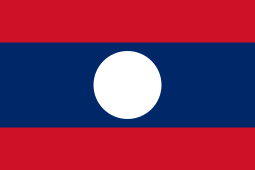Flag of Laos
 |
|
| Use | National flag and ensign |
|---|---|
| Proportion | 2:3 |
| Adopted |
12 October 1945 2 December 1975 (re-adopted) |
| Design | A horizontal triband of red, blue (double height) and red; charged with a white circle in the centre (the diameter of white circle is four-fifths the height of blue band) |
| Designed by | Maha Sila Viravong |
12 October 1945
The flag of Laos was adopted on December 2, 1975. The flag had previously been used by the short-lived Lao Issara government of 1945–46, then by the Pathet Lao.
The flag of Laos consists of three horizontal strips, middle blue strip is twice the height of the top and bottom red stripes. In the middle is a white disc, the diameter of the disc is 4⁄5 the height of the blue stripe. The flag ratio is 2:3. The national flag of Laos was first adopted in 1945 under the Lao Issara government and then re-adopted again in 1975, when the country became a communist people's republic. It is one of the only few flags of a currently communist country (besides Cuba) that does not use any communist symbolism on a national flag and the only current communist country that does not use a five-pointed star in its flag as an emblem.
This flag replaced the 1952-1975 flag of Laos that represented the royal monarchy, which was red, with a triple-headed white elephant on a pedestal beneath a parasol. This expressed the ancient name of the country, "Land of a Million Elephants", and dated from the 19th century. From 1953 onward the royal government waged war with the Pathet Lao, whose flag was blue with a white disk and red borders at the top and bottom.
From 1973 to 1975, the Pathet Lao formed part of the government coalition, before assuming power directly and prompting the abdication of the king. Their flag was adopted as the national flag. According to the original creator of the current Lao flag, Maha Sila Viravong, the white disk in the center symbolizes the unity of the Lao people (and the future reunification of the two Laotian regions of Laos and Northeastern Thailand that are divided by the Mekong River) under one nation. It is also said to represent a full moon against the Mekong River. The red stripes stand for the blood shed by the Lao people on both banks of the Mekong River (the multi-ethnic people of Laos and the Isan people of Northeastern Thailand) in their struggle for freedom and independence from the French, and the blue symbolizes the Mekong River itself, a symbol of the nation's prosperity.
Flag of the Kingdom of Luang Prabang (1707–1893)
...
Wikipedia
